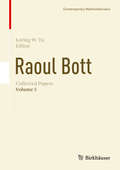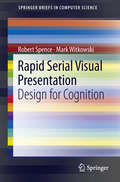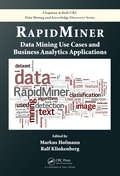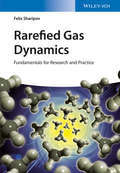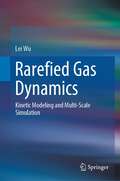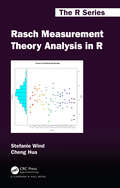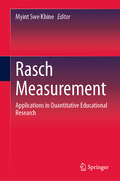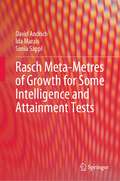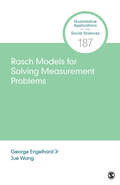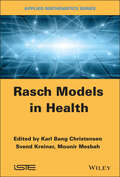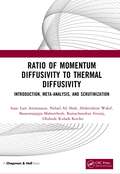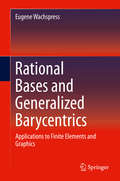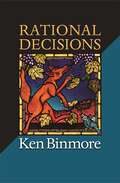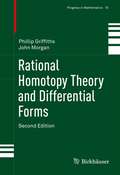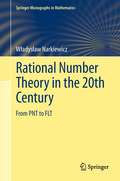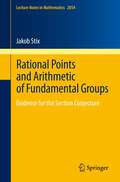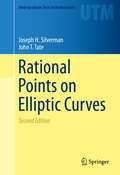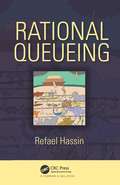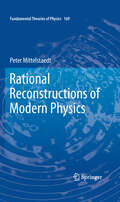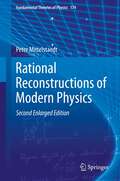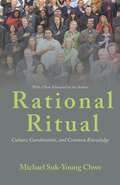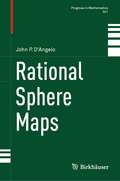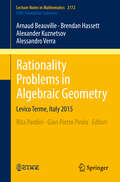- Table View
- List View
Raoul Bott: Volume 5 (Contemporary Mathematicians Ser.)
by Loring W. TuThis book is the fifth and final volume of Raoul Bott’s Collected Papers. It collects all of Bott’s published articles since 1991 as well as some articles published earlier but missing in the earlier volumes. The volume also contains interviews with Raoul Bott, several of his previously unpublished speeches, commentaries by his collaborators such as Alberto Cattaneo and Jonathan Weitsman on their joint articles with Bott, Michael Atiyah’s obituary of Raoul Bott, Loring Tu’s authorized biography of Raoul Bott, and reminiscences of Raoul Bott by his friends, students, colleagues, and collaborators, among them Stephen Smale, David Mumford, Arthur Jaffe, Shing-Tung Yau, and Loring Tu. The mathematical articles, many inspired by physics, encompass stable vector bundles, knot and manifold invariants, equivariant cohomology, and loop spaces. The nonmathematical contributions give a sense of Bott’s approach to mathematics, style, personality, zest for life, and humanity. In one of the articles, from the vantage point of his later years, Raoul Bott gives a tour-de-force historical account of one of his greatest achievements, the Bott periodicity theorem. A large number of the articles originally appeared in hard-to-find conference proceedings or journals. This volume makes them all easily accessible. It also features a collection of photographs giving a panoramic view of Raoul Bott's life and his interaction with other mathematicians.
Rapid Serial Visual Presentation
by Robert Spence Mark WitkowskiA powerful new image presentation technique has evolved over the last twenty years, and its value demonstrated through its support of many and varied common tasks. Conceptually, Rapid Serial Visual Presentation (RSVP) is basically simple, exemplified in the physical world by the rapid riffling of the pages of a book in order to locate a known image. Advances in computation and graphics processing allow RSVP to be applied flexibly and effectively to a huge variety of common tasks such as window shopping, video fast-forward and rewind, TV channel selection and product browsing. At its heart is a remarkable feature of the human visual processing system known as pre-attentive processing, one which supports the recognition of a known image within as little as one hundred milliseconds and without conscious cognitive effort. Knowledge of pre-attentive processing, together with extensive empirical evidence concerning RSVP, has allowed the authors to provide useful guidance to interaction designers wishing to explore the relevance of RSVP to an application, guidance which is supported by a variety of illustrative examples.
RapidMiner: Data Mining Use Cases and Business Analytics Applications (Chapman And Hall/crc Data Mining And Knowledge Discovery Ser. #33)
by Markus HofmannPowerful, Flexible Tools for a Data-Driven WorldAs the data deluge continues in today's world, the need to master data mining, predictive analytics, and business analytics has never been greater. These techniques and tools provide unprecedented insights into data, enabling better decision making and forecasting, and ultimately the solution of incre
Rarefied Gas Dynamics
by Felix SharipovAimed at both researchers and professionals who deal with this topic in their routine work, this introduction provides a coherent and rigorous access to the field including relevant methods for practical applications. No preceding knowledge of gas dynamics is assumed.
Rarefied Gas Dynamics: Kinetic Modeling and Multi-Scale Simulation
by Lei WuThis book highlights a comprehensive description of the numerical methods in rarefied gas dynamics, which has strong applications ranging from space vehicle re-entry, micro-electromechanical systems, to shale gas extraction. The book consists of five major parts: The fast spectral method to solve the Boltzmann collision operator for dilute monatomic gas and the Enskog collision operator for dense granular gas; The general synthetic iterative scheme to solve the kinetic equations with the properties of fast convergence and asymptotic preserving; The kinetic modeling of monatomic and molecular gases, and the extraction of critical gas parameters from the experiment of Rayleigh-Brillouin scattering; The assessment of the fluid-dynamics equations derived from the Boltzmann equation and typical kinetic gas-surface boundary conditions;The applications of the fast spectral method and general synthetic iterative scheme to reveal the dynamics in some canonical rarefied gas flows. The book is suitable for postgraduates and researchers interested in rarefied gas dynamics and provides many numerical codes for them to begin with.
Rasch Measurement Theory Analysis in R (Chapman & Hall/CRC The R Series)
by Stefanie Wind Cheng HuaRasch Measurement Theory Analysis in R provides researchers and practitioners with a step-by-step guide for conducting Rasch measurement theory analyses using R. It includes theoretical introductions to major Rasch measurement principles and techniques, demonstrations of analyses using several R packages that contain Rasch measurement functions, and sample interpretations of results. Features: Accessible to users with relatively little experience with R programming Reproducible data analysis examples that can be modified to accommodate users’ own data Accompanying e-book website with links to additional resources and R code updates as needed Features dichotomous and polytomous (rating scale) Rasch models that can be applied to data from a wide range of disciplines This book is designed for graduate students, researchers, and practitioners across the social, health, and behavioral sciences who have a basic familiarity with Rasch measurement theory and with R. Readers will learn how to use existing R packages to conduct a variety of analyses related to Rasch measurement theory, including evaluating data for adherence to measurement requirements, applying the dichotomous, Rating Scale, Partial Credit, and Many-Facet Rasch models, examining data for evidence of differential item functioning, and considering potential interpretations of results from such analyses.
Rasch Measurement: Applications in Quantitative Educational Research
by Myint Swe KhineThis book focuses on the use of the Rasch measurement model in validation studies and in analyzing the psychometric properties of a variety of test instruments, questionnaires, and scales in international contexts. It broadly examines the development and application of Rasch modeling, providing in-depth analyses of the properties of various scales used in the fields of education, and humanities and social sciences research.The book includes exemplary works on educational research and practices that highlight recent and innovative applications, as well as theoretical and practical aspects of Rasch modeling. Readers will find it helpful to understand the latest approaches to Rasch measurement in educational research, as well as practices for future studies and quantitative research.'This book provides a diverse set of perspectives on Rasch models from scholars across the globe. The volume is both theoretical and applied. The first section of the book provides an overview of Rasch modeling and explains the theoretical and conceptual framework underlying the Rasch model. The remainder of the book highlights multiple applications of the Rasch model within educational assessment as well as several examples of how Rasch modeling can be used for validation studies. This volume showcases the wide variety of ways in which Rasch modeling can be applied to assessment data to provide insights into students’ achievement and learning and to improve instruction.'–Betsy McCoach, University of Connecticut, USA.'A well-written collection of articles. Grouped by the theoretical and applied aspects of Rasch measurement, each chapter in this edited volume makes notable contributions to knowledge and practice. Written by leading scholars in the field, these chapters were written in a clear, succinct, and assertive manner, providing readers with up-to-date information, analyses, and debates. This book should be found in the core collection of emerging researchers and established scholars in educational measurement.'–Timothy Teo, Murdoch University, Australia.
Rasch Meta-Metres of Growth for Some Intelligence and Attainment Tests
by David Andrich Ida Marais Sonia SapplThis book adapts Rasch’s approach for quantifying growth on physiological variables, where growth decelerates, to intellectual variables. To apply this approach, it is necessary to construct measurements in a constant unit over the relevant range of the variable. With such measurements, the book illustrates the approach to quantifying growth on six intellectual variables - two intelligences tests and two each of tests of proficiencies in reading comprehension and mathematics. The book discusses how it is not immediately obvious that deceleration on a quantitative scale should also hold for the growth in intellectual variables. It goes on to show that this is indeed the case with all six tests analysed and considers some implications of this feature for understanding intellectual development, in particular the centrality of the growth trajectory set in early life.
Rasch Models for Solving Measurement Problems: Invariant Measurement in the Social Sciences (Quantitative Applications in the Social Sciences)
by George Engelhard Jue WangThis book introduces current perspectives on Rasch measurement theory with an emphasis on developing Rasch-based scales. Rasch measurement theory represents a paradigm shift in measurement theory away from classical test theory and creates a framework for scaling that can yield invariant measurement. Rasch Models for Solving Measurement Problems: Invariant Measurement in the Social Sciences is a broadly accessible text. Authors George Engelhard Jr and Jue Wang introduce Rasch measurement theory step by step, with chapters on scale construction, evaluation, maintenance, and use. Points are illustrated and techniques are demonstrated through an extended example: The Food Insecurity Experience (FIE) Scale. The Rasch analyses in the book are run using the Facets computer program. Facets syntax, and R code for the ERMA program created by the authors to obtain parameter estimates and to examine model-data fit, together with sample data sets are all available on a website for the book.
Rasch Models for Solving Measurement Problems: Invariant Measurement in the Social Sciences (Quantitative Applications in the Social Sciences)
by George Engelhard Jue WangThis book introduces current perspectives on Rasch measurement theory with an emphasis on developing Rasch-based scales. Rasch measurement theory represents a paradigm shift in measurement theory away from classical test theory and creates a framework for scaling that can yield invariant measurement. Rasch Models for Solving Measurement Problems: Invariant Measurement in the Social Sciences is a broadly accessible text. Authors George Engelhard Jr and Jue Wang introduce Rasch measurement theory step by step, with chapters on scale construction, evaluation, maintenance, and use. Points are illustrated and techniques are demonstrated through an extended example: The Food Insecurity Experience (FIE) Scale. The Rasch analyses in the book are run using the Facets computer program. Facets syntax, and R code for the ERMA program created by the authors to obtain parameter estimates and to examine model-data fit, together with sample data sets are all available on a website for the book.
Rasch Models in Health
by Svend Kreiner Mounir Mesbah Karl Bang ChristensenThe family of statistical models known as Rasch models started with a simple model for responses to questions in educational tests presented together with a number of related models that the Danish mathematician Georg Rasch referred to as models for measurement. Since the beginning of the 1950s the use of Rasch models has grown and has spread from education to the measurement of health status. This book contains a comprehensive overview of the statistical theory of Rasch models.Part 1 contains the probabilistic definition of Rasch models, Part 2 describes the estimation of item and person parameters, Part 3 concerns the assessment of the data-model fit of Rasch models, Part 4 contains applications of Rasch models, Part 5 discusses how to develop health-related instruments for Rasch models, and Part 6 describes how to perform Rasch analysis and document results.
Ratio of Momentum Diffusivity to Thermal Diffusivity: Introduction, Meta-analysis, and Scrutinization
by Isaac Lare Animasaun Nehad Ali Shah Abderrahim Wakif Basavarajappa Mahanthesh Ramachandran Sivaraj Olubode Kolade KorikoThis book presents a systematic introduction, practical meaning, and measurement of thermo-physical properties (i.e. viscosity, density, thermal conductivity, specific heat capacity, and thermal diffusivity) associated with the Prandtl number. The method of slope linear regression through the data points is presented in this textbook as a methodology for a deeper and insightful scrutinization. The book serves as a reference book for scientific investigators, Teachers of Fluid Mechanics, Experts on Heat and Mass Transfer, Researchers on Boundary layer flows, Mechanical and Chemical Engineers, Physicists, and Postgraduate Students working on transport phenomena who need theoretical and empirical reviews on the impact of increasing the ratio of momentum diffusivity to thermal diffusivity. Features: A systematic overview of the state-of-the-art in statistical methodology for understanding changes between dependent and independent variables. Pointers to some theoretical and empirical reviews on Prandtl number. Presents in-depth analysis of various self-similar flows, emphasizing stretching induced flows, nanofluid dynamics, suction, injection, free convection, mixed convection, and forced convection. Insightful study on thermal radiation, heat sour, heat sink, energy flux due to concentration gradient, mass flux due to temperature gradient, thermo-capillary convection flow, Joule heating, viscous dissipation, thermal stratification, thermophoresis, and Brownian motion of particles.
Rational Bases and Generalized Barycentrics
by Eugene WachspressThis three-part volume explores theory for construction of rational interpolation functions for continuous patchwork approximation. Authored by the namesake of the Wachspress Coordinates, the book develops construction of basis functions for a broad class of elements which have widespread graphics and finite element application. Part one is the 1975 book "A Rational Finite Element Basis" (with minor updates and corrections) written by Dr. Wachspress. Part two describes theoretical advances since 1975 and includes analysis of elements not considered previously. Part three consists of annotated MATLAB programs implementing theory presented in Parts one and two.
Rational Decision and Causality
by Ellery EellsFirst published in 1982, Ellery Eells' original work on rational decision making had extensive implications for probability theorists, economists, statisticians and psychologists concerned with decision making and the employment of Bayesian principles. His analysis of the philosophical and psychological significance of Bayesian decision theories, causal decision theories and Newcomb's paradox continues to be influential in philosophy of science. His book is now revived for a new generation of readers and presented in a fresh twenty-first-century series livery, including a specially commissioned preface written by Brian Skyrms, illuminating its continuing importance and relevance to philosophical enquiry.
Rational Decisions (The Gorman Lectures in Economics #4)
by Ken BinmoreIt is widely held that Bayesian decision theory is the final word on how a rational person should make decisions. However, Leonard Savage--the inventor of Bayesian decision theory--argued that it would be ridiculous to use his theory outside the kind of small world in which it is always possible to "look before you leap." If taken seriously, this view makes Bayesian decision theory inappropriate for the large worlds of scientific discovery and macroeconomic enterprise. When is it correct to use Bayesian decision theory--and when does it need to be modified? Using a minimum of mathematics, Rational Decisions clearly explains the foundations of Bayesian decision theory and shows why Savage restricted the theory's application to small worlds. The book is a wide-ranging exploration of standard theories of choice and belief under risk and uncertainty. Ken Binmore discusses the various philosophical attitudes related to the nature of probability and offers resolutions to paradoxes believed to hinder further progress. In arguing that the Bayesian approach to knowledge is inadequate in a large world, Binmore proposes an extension to Bayesian decision theory--allowing the idea of a mixed strategy in game theory to be expanded to a larger set of what Binmore refers to as "muddled" strategies. Written by one of the world's leading game theorists, Rational Decisions is the touchstone for anyone needing a concise, accessible, and expert view on Bayesian decision making.
Rational Homotopy Theory and Differential Forms
by John Morgan Phillip GriffithsThis completely revised and corrected version of the well-known Florence notes circulated by the authors together with E. Friedlander examines basic topology, emphasizing homotopy theory. Included is a discussion of Postnikov towers and rational homotopy theory. This is then followed by an in-depth look at differential forms and de Tham's theorem on simplicial complexes. In addition, Sullivan's results on computing the rational homotopy type from forms is presented. New to the Second Edition: *Fully-revised appendices including an expanded discussion of the Hirsch lemma *Presentation of a natural proof of a Serre spectral sequence result *Updated content throughout the book, reflecting advances in the area of homotopy theory With its modern approach and timely revisions, this second edition of Rational Homotopy Theory and Differential Forms will be a valuable resource for graduate students and researchers in algebraic topology, differential forms, and homotopy theory.
Rational Number Theory in the 20th Century
by Władysław NarkiewiczThe last one hundred years have seen many important achievements in the classical part of number theory. After the proof of the Prime Number Theorem in 1896, a quick development of analytical tools led to the invention of various new methods, like Brun's sieve method and the circle method of Hardy, Littlewood and Ramanujan; developments in topics such as prime and additive number theory, and the solution of Fermat's problem. Rational Number Theory in the 20th Century: From PNT to FLT offers a short survey of 20th century developments in classical number theory, documenting between the proof of the Prime Number Theorem and the proof of Fermat's Last Theorem. The focus lays upon the part of number theory that deals with properties of integers and rational numbers. Chapters are divided into five time periods, which are then further divided into subject areas. With the introduction of each new topic, developments are followed through to the present day. This book will appeal to graduate researchers and student in number theory, however the presentation of main results without technicalities will make this accessible to anyone with an interest in the area.
Rational Points and Arithmetic of Fundamental Groups
by Jakob StixThe section conjecture in anabelian geometry, announced by Grothendieck in 1983, is concerned with a description of the set of rational points of a hyperbolic algebraic curve over a number field in terms of the arithmetic of its fundamental group. While the conjecture is still open today in 2012, its study has revealed interesting arithmetic for curves and opened connections, for example, to the question whether the Brauer-Manin obstruction is the only one against rational points on curves. This monograph begins by laying the foundations for the space of sections of the fundamental group extension of an algebraic variety. Then, arithmetic assumptions on the base field are imposed and the local-to-global approach is studied in detail. The monograph concludes by discussing analogues of the section conjecture created by varying the base field or the type of variety, or by using a characteristic quotient or its birational analogue in lieu of the fundamental group extension.
Rational Points on Elliptic Curves
by Joseph H. Silverman John T. TateThe theory of elliptic curves involves a pleasing blend of algebra, geometry, analysis, and number theory. This volume stresses this interplay as it develops the basic theory, thereby providing an opportunity for advanced undergraduates to appreciate the unity of modern mathematics. At the same time, every effort has been made to use only methods and results commonly included in the undergraduate curriculum. This accessibility, the informal writing style, and a wealth of exercises make Rational Points on Elliptic Curves an ideal introduction for students at all levels who are interested in learning about Diophantine equations and arithmetic geometry. Most concretely, an elliptic curve is the set of zeroes of a cubic polynomial in two variables. If the polynomial has rational coefficients, then one can ask for a description of those zeroes whose coordinates are either integers or rational numbers. It is this number theoretic question that is the main subject of Rational Points on Elliptic Curves. Topics covered include the geometry and group structure of elliptic curves, the Nagell-Lutz theorem describing points of finite order, the Mordell-Weil theorem on the finite generation of the group of rational points, the Thue-Siegel theorem on the finiteness of the set of integer points, theorems on counting points with coordinates in finite fields, Lenstra's elliptic curve factorization algorithm, and a discussion of complex multiplication and the Galois representations associated to torsion points. Additional topics new to the second edition include an introduction to elliptic curve cryptography and a brief discussion of the stunning proof of Fermat's Last Theorem by Wiles et al. via the use of elliptic curves.
Rational Queueing (Chapman & Hall/CRC Series in Operations Research)
by Refael HassinUnderstand the Strategic Behavior in Queueing SystemsRational Queueing provides one of the first unified accounts of the dynamic aspects involved in the strategic behavior in queues. It explores the performance of queueing systems where multiple agents, such as customers, servers, and central managers, all act but often in a noncooperative manner.T
Rational Reconstructions of Modern Physics
by Peter MittelstaedtNewton’s classical physics and its underlying ontology are loaded with several metaphysical hypotheses that cannot be justified by rational reasoning nor by experimental evidence. Furthermore, it is well known that some of these hypotheses are not contained in the great theories of modern physics, such as the theory of relativity and quantum mechanics. This book shows that, on the basis of Newton’s classical physics and by rational reconstruction, the theory of relativity as well as quantum mechanics can be obtained by partly eliminating or attenuating the metaphysical hypotheses. Moreover, it is shown that these reconstructions do not require additional hypotheses or new experimental results.
Rational Reconstructions of Modern Physics, 2nd Enlarged Edition
by Peter MittelstaedtNewton's classical physics and its underlying ontology are loaded with several metaphysical hypotheses that cannot be justified by rational reasoning nor by experimental evidence. Furthermore, it is well known that some of these hypotheses are not contained in the great theories of Modern Physics, such as the theory of Special Relativity and Quantum Mechanics. This book shows that, on the basis of Newton's classical physics and by rational reconstruction, the theory of Special Relativity as well as Quantum Mechanics can be obtained by partly eliminating or attenuating the metaphysical hypotheses. Moreover, it is shown that these reconstructions do not require additional hypotheses or new experimental results. <P><P> In the second edition the rational reconstructions are completed with respect to General Relativity and Cosmology. In addition, the statistics of quantum objects is elaborated in more detail with respect to the rational reconstruction of quantum mechanics. The new material completes the approach of the book as much as it is possible at the present state of knowledge. Presumably, the most important contribution that is added to the second edition refers to the problem of interpretation of the three great theories of Modern Physics. It is shown in detail that in the light of rational reconstructions even realistic interpretations of the three theories of Modern Physics are possible and can easily be achieved.
Rational Ritual: Culture, Coordination, and Common Knowledge
by Michael Suk-Young ChweWhy do Internet, financial service, and beer commercials dominate Super Bowl advertising? How do political ceremonies establish authority? Why does repetition characterize anthems and ritual speech? Why were circular forms favored for public festivals during the French Revolution? This book answers these questions using a single concept: common knowledge. Game theory shows that in order to coordinate its actions, a group of people must form "common knowledge." Each person wants to participate only if others also participate. Members must have knowledge of each other, knowledge of that knowledge, knowledge of the knowledge of that knowledge, and so on. Michael Chwe applies this insight, with striking erudition, to analyze a range of rituals across history and cultures. He shows that public ceremonies are powerful not simply because they transmit meaning from a central source to each audience member but because they let audience members know what other members know. For instance, people watching the Super Bowl know that many others are seeing precisely what they see and that those people know in turn that many others are also watching. This creates common knowledge, and advertisers selling products that depend on consensus are willing to pay large sums to gain access to it. Remarkably, a great variety of rituals and ceremonies, such as formal inaugurations, work in much the same way. By using a rational-choice argument to explain diverse cultural practices, Chwe argues for a close reciprocal relationship between the perspectives of rationality and culture. He illustrates how game theory can be applied to an unexpectedly broad spectrum of problems, while showing in an admirably clear way what game theory might hold for scholars in the social sciences and humanities who are not yet acquainted with it. In a new afterword, Chwe delves into new applications of common knowledge, both in the real world and in experiments, and considers how generating common knowledge has become easier in the digital age.
Rational Sphere Maps (Progress in Mathematics #341)
by John P. D’AngeloThis monograph systematically explores the theory of rational maps between spheres in complex Euclidean spaces and its connections to other areas of mathematics. Synthesizing research from the last forty years, the author aims for accessibility by balancing abstract concepts with concrete examples. Numerous computations are worked out in detail, and more than 100 optional exercises are provided throughout for readers wishing to better understand challenging material.The text begins by presenting core concepts in complex analysis and a wide variety of results about rational sphere maps. The subsequent chapters discuss combinatorial and optimization results about monomial sphere maps, groups associated with rational sphere maps, relevant complex and CR geometry, and some geometric properties of rational sphere maps. Fifteen open problems appear in the final chapter, with references provided to appropriate parts of the text. These problems will encourage readers to apply the material to future research.Rational Sphere Maps will be of interest to researchers and graduate students studying several complex variables and CR geometry. Mathematicians from other areas, such as number theory, optimization, and combinatorics, will also find the material appealing.
Rationality Problems in Algebraic Geometry
by Brendan Hassett Alexander Kuznetsov Arnaud Beauville Alessandro Verrarita Pardini Gian Pietro PirolaProviding an overview of the state of the art on rationality questions in algebraic geometry, this volume gives an update on the most recent developments. It offers a comprehensive introduction to this fascinating topic, and will certainly become an essential reference for anybody working in the field. Rationality problems are of fundamental importance both in algebra and algebraic geometry. Historically, rationality problems motivated significant developments in the theory of abelian integrals, Riemann surfaces and the Abel-Jacobi map, among other areas, and they have strong links with modern notions such as moduli spaces, Hodge theory, algebraic cycles and derived categories. This text is aimed at researchers and graduate students in algebraic geometry.
